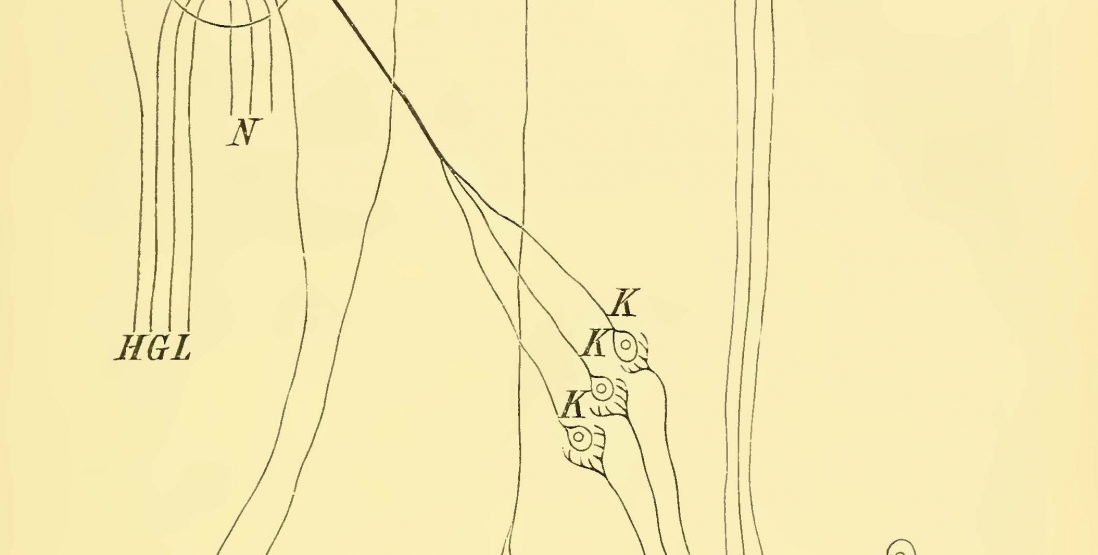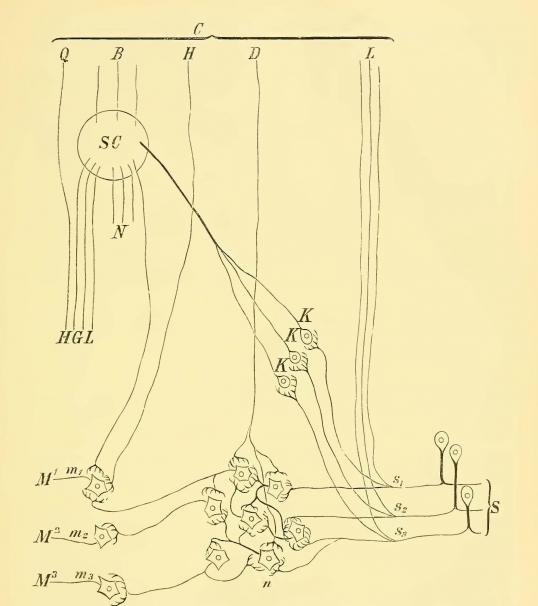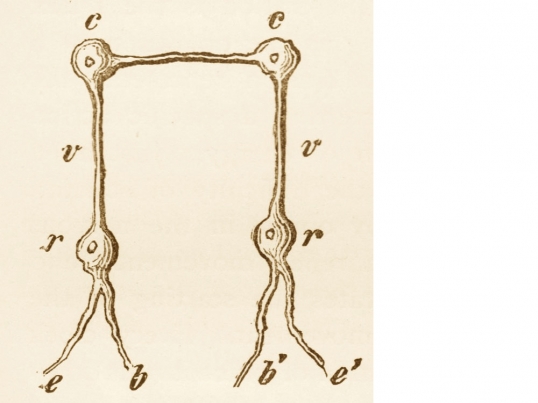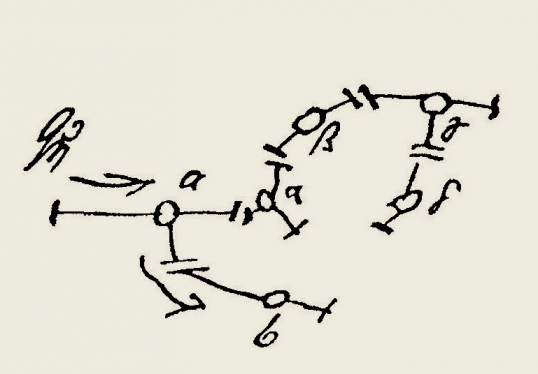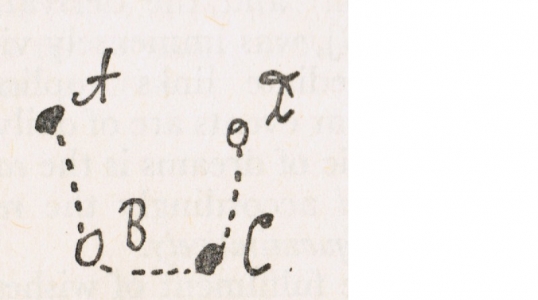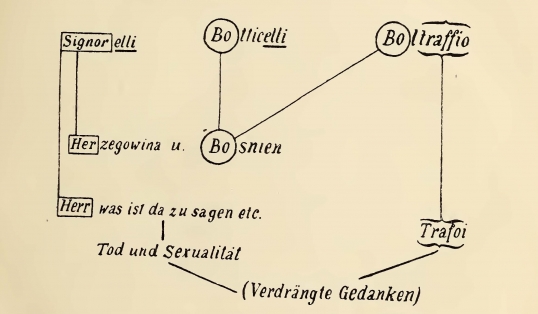Neurons and Signifiers
What does it mean to bring the latest findings of neuroscience to bear on architecture? Results of neuroscientific research have been presented as silver bullets in a wide range of disciplines, including law, art history, archaeology, philosophy, etc.1 So far, neuroscience has remained a marginal affair in the discipline of architecture—perhaps because its conclusions offer little more than rehashed phenomenology (not the philosophical but the architectural variety) a tendency that has been at work in the discipline at least since the end of the nineteenth century.2 Still, the potential influence of neuroscience on the discipline is not to be overlooked .3 I want to argue here that architecture’s newfound fascination with neuroscience needs to be taken more seriously as it is indicative of epistemological changes that are taking place both within and beyond the discipline.4 Consider, for example, the art historian Norman Bryson’s characterization of the so-called “neural turn,” a twenty-first-century development, which, he has claimed, has eclipsed the twentieth-century’s “linguistic turn”:
The radicalism of neuroscience consists in its bracketing out the signifier as the force that binds the world together: what makes the apple is not the signifier “apple” (though this, too, may play an important role in the process of reality-building), but rather the simultaneous firing of axons and neurons within cellular and organic life. The level of the ground of being, or of the real, shifts from the signifier to the neural configuration, the orchestration of myriad plays of lightning across the ramifying branches of the brain.5
“Cognitive neuroscience,” Bryson explains, “is hardly the first discipline to have questioned the security of ontological categories.”6 But whereas critical theory turned ontological questions into questions of language —think of Saussure’s semiotics, Derrida’s différance, or Lacan’s symbolic order—neuroscience stabilizes the real in a different manner. It argues that an apple is an apple, Bryson continues, not because the real thing imprints itself on the senses, like a seal imprinting itself on a wax tablet, or because we call it an “apple,” but rather because neurons that are fired together are wired together. This is not the Bryson who two decades ago wrote about “natural attitude” inherent in the perceptualism of Western art.7 He now welcomes neuroscience’s elimination of signification: critical theory with its reliance on language has assumed a deeply cognitivist and, Bryson adds, inherently clerical stance which stands to be corrected as neuroscience unearths the silent intelligence lodged in the body and brings the “creatural life of the body and of embodied experience” to the fore.8 According to Bryson, the reality constructed through the pre-linguistic “configurations of the neural body” is therefore more “real” than that constructed under the “primacy of the signifier.”9 This, of course, is one of the central claims of affect theory as well, and the choir of neuroscience enthusiasts would add others to the list of advantages brought about by the “neural turn”: that it will make us more global, more interdisciplinary, and even more post-human.10
Architectural theory in North America has been under the “primacy of the signifier” for the past few decades. If we are to believe Bryson about the arrival of the neural turn, what kind of knowledge might the discipline of architecture produce under the spell of the neuron? Before we join the neuro-euphoria, however, we should ask: what happens to a discipline when the signifier is closed off by neurons as Bryson claims? What epistemological and ethical consequences should we expect?
§ 1
As a way of thinking through these questions, I will take you through a similar dilemma faced over a century ago by Sigmund Freud in the midst of passionate debates at universities in German-speaking countries about the demarcation of disciplines. Freud’s dilemma between neurons and signifiers becomes particularly pronounced in a diagram that he drew in 1895 as part of a book that he planned to call Entwurf einer Psychologie, a psychological treatise for neurologists, although he never finished the manuscript and almost destroyed it.11
Fig. 1.
Sigmund Freud, Entwurf einer Psychologie (Project for a Scientific Psychology), manuscript of 1895. Sigmund Freud Collection, Library of Congress.
Fig. 2.
Sigmund Freud, Die Traumdeutung (The Interpretation of Dreams) (Leipzig und Wien: Franz Deuticke, 1900), figs. 1-3.
Yet reading the Entwurf, one gets the sense that it was precisely the networked nature of neurons that remained problematic for Freud. At a moment when psychology was considered a test case in debates in the organization of the disciplines, Freud stated his naturalistic attitude unequivocally: “the intention is to furnish a psychology that shall be a natural science,” reads the opening sentence of the Entwurf, “that is, to represent psychical processes as quantitatively determinate states of specifiable material particles.”13 The Entwurf describes an “economics of nervous force,” a state of equilibrium achieved between cathexis (Besetzung, “energization”) and inhibition (Hemmung) of nervous energy. An elusive quantity of energy Qη—a material entity, Freud explains, that is “subject to the general laws of motion” and that is therefore unmistakably in the jurisdiction of the natural sciences—moves through “contact-barriers,” neural gaps that would later be called “synapses,” with the ultimate goal of achieving a state of inertia resembling homeostasis.14 According to the Entwurf, there exist two classes of neurons: permeable neurons which “after each passage of excitation are in the same state as before,” and, more crucially, impermeable neurons which are loaded with resistance, are altered by the passage of energy, and are therefore able to retain traces of the passage. Memory, according to this scheme, is dependent not on the neurons themselves but rather on the degree of facilitation (in German Bahnung with implications of “grooving”) between them. Because it is only the resistant, impermeable neurons that retain the memory of an impulse, inhibition is described in the Entwurf as a process crucial to the possibility of an ego.15
Freud was not alone in imagining the nerves as an elaborate network resembling wiring diagrams used to design and describe electric circuits at the end of the nineteenth century.16
Fig. 3.
Sigmund Exner, Entwurf zu einer physiologischen Erklärung psychischen Erscheinungen (Leipzig und Wien: Franz Deuticke, 1894), fig. 56.
Fig. 4.
Wilhelm Wundt, Vorlesungen über die Menschen- und Thierseele (Leipzig: L. Voss, 1863), 208.
By contrast, Freud’s 1895 wiring diagram of a neural network demonstrates interference between nervous excitations at the lower levels without the intervention of the brain or the spinal cord. The diagram is marked by an unexpected interruption: the cathexis (Besetzung) of one branch (a-b) facilitates the discharge of an excited neuron in a direction away from the neuron’s connection with those neurons responsible for a motor response (a-α). In other words, all excitations are functionally and temporally interdependent here. If, Freud explains, (a) represents a hostile image and (b) is a key path to unpleasure, then the nervous impulse is directed to (α).19 The secondary branch inhibits and overlays the primary: it functions by imposing experience and memory on the primary process in order to avoid unpleasure or pain.20
Fig. 5.
Sigmund Freud, detail of Entwurf einer Psychologie (Project for a Scientific Psychology), manuscript of 1895. Sigmund Freud Collection, Library of Congress.
It is precisely this kind of thinking about neural networks in the Entwurf that excites neuroscientists today.21 In Freud’s diagram, they see the model of a temporally and functionally dynamic network. They argue that Freud’s system of contact-barriers which would enable a human or machine to make suitable choices based on the memory of previous events and which uses feedback as a means of correcting errors anticipates Dewey’s reflex arc, Sherrington’s integrative action, the Hebbian synapse, theories of neuroplasticity, and, ultimately, computational thinking.22 What makes Freud’s diagram appealing is its prescient “dynamism” and its difference from Wundt’s mechanical wiring diagram.23 If in the Wundtian scheme consciousness figures as the apperception of afferent sensations by a centered, willed consciousness, in the Entwurf nervous signals are transmitted according to the binary choices of pleasure or pain.
And yet paradoxically this is exactly where Freud’s naturalism also runs into trouble in the Entwurf. The dynamism of the neural network notwithstanding, the question lingers: if any given Qη cathects entire regions of neurons, why does the nervous energy not move without friction in the system? Why do some paths of facilitation prove more resistant and therefore more persistent than others? “To assume that there is an ultimate difference between the valence of the contact-barriers of φ and of ψ,” Freud observes uneasily, “has once more an unfortunate tinge of arbitrariness.”24 What produces difference in the seemingly undifferentiated network of neurons? What is the motive, wonders Freud, without being able to provide a satisfactory answer.
The question that Freud thus poses in the Entwurf is nothing less profound than the question of causality. This, after all, was the central problem that turn-of-the-century debates about the organization of the disciplines had inherited from nineteenth-century theology: historians have demonstrated how Protestant theologians reacted to the pressure of mid-nineteenth-century mechanistic theories by gradually withdrawing their claims about nature and ultimately leaving causal explanation to the natural sciences.25 Thus, every attempt at disciplinary arrangement at the end of the nineteenth century was implicitly also a teleological proposition. That is not to say, however, that the nineteenth-century natural sciences housed within universities subscribed to a materialist worldview. For Wundt, for example, psychology had to have a stereoscopic disciplinary perspective. On the one hand, it tried to analytically explain physical causality using experimental methods: by measuring breathing, pulse, speed of nervous transmission, etc. On the other, however, psychology had to describe psychic causality through methodical introspection.26 Wundtian psychology, conceived as a propaedeutic science, busied itself with shuttling back and forth between the analytic methods of the natural sciences and the interpretive methods of the human sciences but always under the surveillance of philosophy, the queen of the disciplines.27
It was precisely this reductionism rejected by Wundt that Freud aspired to undertake in the Entwurf, which starts bluntly with the declaration that psychology is a natural science. Yet, it seems, halfway through the manuscript Freud has a change of heart. By the time another diagram of cathexis appears in the book, a diagram whose structure is similar to that of the earlier diagram of neurons, what is sketched is not the functioning of neurons but rather the famous story of Irma’s injection that would appear in 1900 in The Interpretation of Dreams.
Fig. 6.
Sigmund Freud, detail of Entwurf einer Psychologie (Project for a Scientific Psychology), manuscript of 1895. Sigmund Freud Collection, Library of Congress.
Fig. 7.
Sigmund Freud, “Zum psychischen Mechanismus der Vergesslichkeit” (The Physical Mechanism of Forgetfulness) Monatsschrift für Psychiatrie und Neurologie 4.6 (Dec. 1898), fig. 1.
Let A be a dream idea which has become conscious and which leads to B. But instead of B, C is found in consciousness and this is because [it] lies on the pathway between B and a D cathexis which is simultaneously present. Thus there is a diversion brought about by a simultaneous cathexis, of a different kind, which, incidentally, is not itself conscious. For that reason, then, C has taken the place of B, though B fits in better with the connection of thought, with the wish-fulfillment.29
Why did Freud abandon his naturalism halfway? Why did he turn away from the naturalistic framework according to which information travels through a homogeneous network of neurons and towards a normative one, according to which the unconscious is understood with reference to a system of signification analogous to language? For those who find in Freud’s Entwurf the intimations of contemporary neuroscience, Freud left the manuscript unfinished because he did not yet have the empirical evidence about the workings of neurons.30 It is, of course, neither possible nor terribly useful to try to reconstruct what Freud was really thinking. More relevant here is that he could not answer the questions that he asked about the path that neural energy followed within the epistemological framework that he had set up for himself at the beginning of the Entwurf, namely with the framework of psychology as a natural science. For even in the absence of an explicit theological subtext, the question of causality remains a question of teleology; once unbridled, it can never be fully answered but only be infinitely deferred.
Freud must have realized the paradox: that accounting for the errant pathway of the nervous energy would ultimately require nothing less than what Derrida would call a transcendental signified. Instead of deferring the question, he seems to have decided to anchor it on the plane of ethics—that is, in the realm of human action.31 That is to say, unable to account for the side-cathexis in exclusively mechanical terms as a matter of inhibition, he characterized it as a matter of repression, a mechanism crucial, as Freud would subsequently argue, to sublimation and mediating primitive urges in the social world.32 As Lacan would later point out, it was with the insertion of repression that the structure of the neural cathexis became linguistic. The investigation of the unconscious was always suspended in a flux of associative chains: the substitutive formation of repression was similar to the incessant sliding of the signifier and the signified, essential to the production of meaning through the interplay of difference in structural linguistics. To put it in Lacanian terms, what distinguished Freud’s psychology from its precedents was that the unconscious was structured like language and operated with the mechanism of repression.33
§ 2
I worry that what threatens to disappear in architecture schools today along with critical theory, which arguably owed its existence to the linguistic turn, is acknowledgement of mechanisms of repression—which is simply another way of saying “politics.” I worry that the new architectural theory shaped under the spell of the neuron, the carbon atom, and the algorithm will be a discourse that asks only questions of cause and effect of a world assumed to be an undifferentiated network of things. This is not to say that an architectural theory predicated on linguistic models is the only way to acknowledge politics, but it is clear that a discipline that borrows its modes of inquiry from the natural sciences wholesale will not only be unable to answer but also unwilling to ask the question of where mechanisms of repression in that flattened world may be.
A year before Freud wrote the Entwurf, the philosopher Wilhelm Windelband, the principal representative of the Southwest school of Neo-Kantianism, gave a rectorial address in which he proposed a new principle for the organization of the disciplines at the university.34 What he called the nomothetic sciences, encompassing most of what would be called natural sciences under other systems of disciplinary classification, were to be separated from the idiographic sciences, the purview of the humanities and the social sciences. Nomothetic sciences inquired into general laws and pursued apodictic judgments whereas idiographic sciences examined singular historical facts and produced assertoric propositions.35 Over against Wundt who had granted psychology a privileged position as a “bridge” between the natural and human sciences, Windelband categorized psychology as one natural science among others. Historians tell us that the disciplinary debates in German-speaking countries at the end of the nineteenth century ended with the triumph of the neo-Kantians.36 Windelband’s 1894 plan for the organization of the disciplines might then be considered a truce agreement, honored both by natural scientists and humanists for most of the twentieth century.
In the second decade of the twenty-first century, the neo-Kantian truce agreement from the turn of the last century seems to have been broken. Claims of interdisciplinarity are no longer confined exclusively to the humanities or the natural sciences side. In other words, we may be standing at a juncture like Freud did over a hundred years ago. What will we do? Will we develop a new architectural theory that will allow us to talk about neurons, carbon atoms, or algorithms without losing sight of mechanisms of repression? Or will we surrender unconditionally to the allure of the neurons?
✓ Not peer-reviewed
Zeynep Çelik Alexander, “Neurons and Signifiers,” Aggregate 3 (March 2015), https://doi.org/10.53965/HOFU2252.
- 1
Consider the Neurohumanities Research Group at the John Hope Franklin Humanities Institute at Duke University, the Neuro-Salon that opened on the occasion of the Neuro Humanities Entanglement Conference at Georgia Tech, and the Art and Neuroscience Project at the Italian Academy for Advanced Studies in America at Columbia University. In the case of architecture, the most ambitious enterprise so far seems to have been the Academy of Neuroscience for Architecture, which organized conferences in 2012 and 2014 at the Salk Institute in San Diego.
↑ - 2
See, for example, Sarah Goldhagen, “Alvar Aalto’s Astonishing Rationalism,” A Field Guide to a New Meta-Field: Bridging the Humanities-Neuroscience Divide, ed. B. M. Stafford (Chicago and London: University of Chicago Press, 2011): 267-308. For a history of phenomenology in architectural discourses, see Jorge Otero-Pailos, Architecture’s Historical Turn: Phenomenology and the Rise of the Postmodern (Minneapolis: University of Minnesota Press, 2010).
↑ - 3
See, for example, the conference “Sculpting the Architectural Mind” to take place at the Pratt Institute between March 6-7, 2015.
↑ - 4
For a longer discussion of some of these changes, see my “Neo-Naturalism,” Log 31, New Ancients, ed. Dora Epstein Jones and Bryony Roberts (Summer 2014): 23-30.
↑ - 5
Norman Bryson, “Introduction: The Neural Interface,” Blow-Up: Photography, Cinema, and the Brain, essays by Warren Neidich (New York and Riverside: Distributed Art Publishers and UCR/ California Museum of Photography, 2003), 14.
↑ - 6
Bryson, “Introduction: The Neural Interface,” 13.
↑ - 7
Norman Bryson, “The Natural Attitude,” Vision and Painting: The Logic of the Gaze (New Haven and London: Yale University Press, 1983): 10-12.
↑ - 8
Bryson, “Introduction: The Neural Interface,” 14.
↑ - 9
Bryson, “Introduction: The Neural Interface,” 14.
↑ - 10
See these concerns in Barbara Maria Stafford, “Crystal and Smoke: Putting Image Back in Mind,” A Field Guide to a New Meta-Field, 1-63.
↑ - 11
Sigmund Freud, “Project for a Scientific Psychology,” [1895] Standard Edition of the Complete Psychological Works of Sigmund Freud, vol. 1, Pre-Psycho-Analytic Publications and Unpublished Drafts (1886-1899), trans. James Strachey, (London: Hogarth Press and the Institute of Psycho-Analysis, 1966): 281-397. First published in German in 1950 as Aus den Anfängen der Psychoanalyse. I will refer to the page numbers in the English Standard edition, in which the diagram appears on page 324. For Freud’s drawings, see Lynn Gamwell and Mark Solms, From Neurology to Psychoanalysis: Sigmund Freud’s Neurological Drawings and Diagrams of the Mind (New York: Binghamton University Art Museum, State University of New York, 2006).
↑ - 12
John Onians, Neuroarthistory: From Aristotle and Pliny to Baxandall and Zeki (New Haven: Yale University Press, 2007) 143-144.
↑ - 13
Freud, “Project for a Scientific Psychology,” 295.
↑ - 14
Freud, “Project for a Scientific Psychology,” 298-299.
↑ - 15
Freud, “Project for a Scientific Psychology,” 322-324.
↑ - 16
Freud’s indebtedness to Sigmund Exner’s Entwurf zu einer physiologischen Erklärung psychischen Erscheinungen (1894) has been acknowledged in Frank J. Sulloway, Freud, Biologist of the Mind: Beyond Psychoanalytic Legend (New York: Basic Books, 1979), 116 and Fulvio Marone, “Suggestions from the Unconscious: Freud, Hypnosis, and the Mind-Body Problem,” The Pre-Psychoanalytic Writings of Sigmund Freud, ed. Gertrudis van de Vijver and Filip Geerardyn (London: Karnac, 2002), 231. For the question of control before cybernetics, see James R. Beniger, The Control Revolution: Technological and Economic Origins of the Information Society (Cambridge: Harvard University Press, 1986).
↑ - 17
Wilhelm Wundt, Vorlesungen über die Menschen- und Thierseele (Leipzig: L. Voss, 1863), 207.
↑ - 18
Wilhelm Wundt, Grundzüge der physiologischen Psychologie, vol. 1, 5th edition (Leipzig: Wilhelm Engelmann, 1902), 85-86.
↑ - 19
Freud, “Project for a Scientific Psychology,” 312.
↑ - 20
For a history of inhibition, see Roger Smith, Inhibition: History and Meaning in the Sciences of Mind and Brain (London: Free Association, 1992). Smith traces the history of this concept and its transformation into the twentieth-century concept of control. See note 22.
↑ - 21
This view can be found as early as in 1962 in Karl H. Pribram, “The Neuropsychology of Sigmund Freud,” Experimental Foundations of Clinical Psychology, ed. Arthur J. Bachrach (New York: Basic Books, 1962): 442-468. In this text, Pribram posits Freud’s Project as a “Rosetta Stone” for a “single scientific universe of discourse.” Pribram, “The Neuropsychology of Sigmund Freud,” 462.
↑ - 22
See, for example, Geoffrey D. Schott, “Freud’s Project and Its Diagram: Anticipating the Hebbian Synapse,” Journal of Neurology, Neurosurgery, and Psychiatry, 82.2 (February 2011): 122-125 and Diego Centonze et al., “The Project for a Scientific Psychology (1895): A Freudian Anticipation of LTP-Memory Connection Theory,” Brain Research Reviews 46 (2004): 310-314. For Freud’s frequent reference to a “backward” flow of nervous energy, see the editor’s appendix on regression in Freud, “Project for a Scientific Psychology,” 344-346.
↑ - 23
Schott, “Freud’s Project and Its Diagram: Anticipating the Hebbian Synapse,” 123.
↑ - 24
Freud, “Project for a Scientific Psychology,” 303.
↑ - 25
Frederick Gregory, Nature Lost? Natural Science and the German Theological Traditions of the Nineteenth Century (Cambridge, MA: Harvard University Press, 1992).
↑ - 26
Almost every Wundt book starts with a discussion of this dual mission of psychology. See for example, Wundt, “Aufgabe der physiologischen Psychologie,” Grundzüge der physiologischen Psychologie, 1-12. For a good explication of Wundt’s disciplinary project, see Kurt Danziger, Constructing the Subject: Historical Origins of Psychological Research (Cambridge: Cambridge University Press, 1990).
↑ - 27
Wundt had no interest in transforming psychology into a purely experimental science that had no ties to philosophy. For a subtle discussion of Wundt’s disciplinary project, see Danziger, Constructing the Subject, 37-42.
↑ - 28
Freud, The Psycho-Pathology of Everyday Life [1901], Standard Edition of the Complete Psychological Works of Sigmund Freud ed. James Strachey, trans Alan Tyson (London: Bouverie House, 1966), 5.
↑ - 29
Freud, “Project for a Scientific Psychology,” 341.
↑ - 30
See Schott, “Freud’s Project and Its Diagram: Anticipating the Hebbian Synapse” and Diego Centonze et al., “The Project for a Scientific Psychology (1895): A Freudian Anticipation of LTP-Memory Connection Theory.”
↑ - 31
Lacan recognized in the mechanistic language of the Entwurf “something unmatched in significance, something that has changed the problems of the ethical perspective for us to a degree that we are not yet aware of.” Lacan, “Rereading the Entwurf” [1959], The Seminar of Jacques Lacan, Book VII, The Ethics of Psychoanalysis, 1959-1960, trans. Dennis Porter, ed. Jacques-Alain Miller (New York and London: W. W. Norton, 1992), 36.
↑ - 32
Freud, Civilization and Its Discontents [1929-1930], Standard Edition of the Complete Psychological Works of Sigmund Freud, trans. James Strachey, vol. 21, (London: Hogarth Press and the Institute of Psycho-Analysis, 1961): 57-146.
↑ - 33
Jacques Lacan, “The Agency of the Letter in the Unconscious or Reason since Freud,” [1957] Écrits, A Selection, trans. Alan Sheridan (New York and London: W. W. Norton, 1977): 146-178. For Lacan’s discussion of the Project, see Lacan, “The Freudian Schemata of the Psychic Apparatus,” [1955] The Seminar of Jacques Lacan, Book II, The Ego in Freud’s Theory and in the Technique of Psychoanalysis, trans. Sylvana Tomaselli (New York and London: W. W. Norton, 1978): 93-171 and “Rereading the Entwurf,” 35-42.
↑ - 34
Wilhelm Windelband, “Geschichte und Naturwissenschaft. Straßburger Rektoratsrede” [1894] Präludien: Aufsätze und Reden zur Philosophie und ihrer Geschichte (Tübingen: J. C. B. Mohr, 1915): 136-160. Translated as “Rectorial Address, Strasbourg, 1894,” History and Theory 19.2 (Feb. 1980): 169-185.
↑ - 35
Windelband, “Rectorial Address,” 175.
↑ - 36
See R. Lanier Anderson, “The Debate over the Geisteswissenschaften in Germany Philosophy,” The Cambridge History of Philosophy, 1870-1945, vol. 1, ed. Thomas Baldwin (New York: Cambridge University Press, 2003) 223-225 as well as the volume Uljana Feest, ed., Historical Perspectives on Erklären and Verstehen, (Dordrecht, Heidelberg, London, New York: Springer, 2010).
↑
